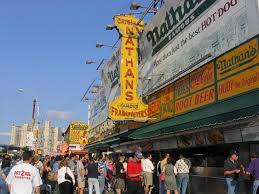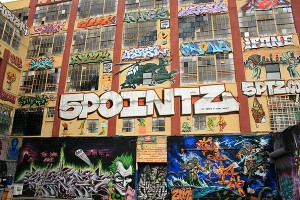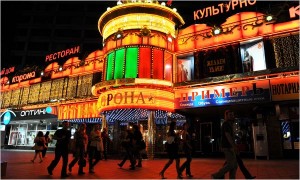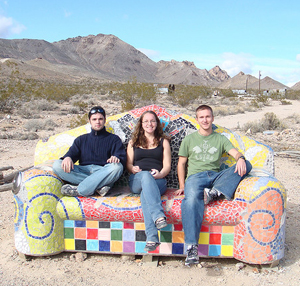The russians are coming, the russians are coming

They call it Little Odessa because it’s on the sea, but the Brighton Beach section of Brooklyn could just as easily be called Little Moscow or Little St. Petersburg, or even Little Minsk. The area is home to an estimated 100,000 former residents of the former Soviet Union who have created a vibrant and massive immigrant community that is helping to reshape civic life in New York City.
Walk along Brighton Beach Avenue, the main shopping street for this community where New York Bay spills into the Atlantic Ocean, and most of the shops have signs in the Cyrillic alphabet. Up and down the street, the lingua franca is Russian, and you can buy everything from the old country: food and drink flown in from Russia, Russian magazines and videos, fur hats and religious icons.
While the Russian oligarchs go to London, the plain folks are in Brighton Beach, far and away the largest grouping of Russian emigres anywhere in the world.
A few blocks from Brighton Beach Avenue, a wooden boardwalk lines the lengthy beach, and most evenings it is crammed with strolling groups, there to meet and greet, to see and be seen, to run into someone who comes from their village or their old neighborhood in Moscow or Novosibirsk or Kiev or Odessa. Everyone is decked out in their finest to show they’re doing OK in America. As soon as it turns a little colder, every Russian woman has her mink coat, and the men have their finest full length leather coat, the height of fashion — if this were still 1985 and they were still in St. Petersburg.
There was a spurt of Russian immigration to the U.S. in the period 1880 to 1910 as Jews fled pogroms. New laws limited immigration after 1910, but another group made it in after the Russian revolution in 1917. Those now living in Brighton Beach represent a different era: In the 1970s, the U.S. led an effort to ease Soviet immigration restrictions – and this was tied to trade policy. So in the 1970s and ‘80s, there was an outpouring of people, including about 1.3 million Jews. Perhaps a million chose to go to Israel, while a substantial number went to the U.S. (and, surprisingly, also to Germany.)
Jewish communities across America mobilized to help their brethren. These were not simply co-religionist but also people from the same Eastern European places and experiences as most American Jews, who are typically only two or three generations removed from the shtetls, the small Jewish towns of Russia and its Pale of Settlement.
In mid-sized cities like Omaha or Memphis, local Jewish communities agreed to take several families: they would find them an apartment and a job, get someone to help them learn English, and introduce them to American life. New York was a different story. As the nation’s largest city, and the city with the largest Jewish population in the world, it agreed to take on thousands. But where to put them: As it happened, Coney Island and Brighton Beach, areas on the far side of Brooklyn, had fallen on hard times: Once a popular seaside resort area, it was in decline as the city dumped thousands of low income minorities into high rise housing projects. The result was rampant crime and decay. Cynics suggest that the Russians were put out in Brighton not only because there was space but also because they would keep the area from becoming completely black.
But out of nothing, the Russians have built a community. America is truly a melting pot, assimilating everyone from everywhere. But the process is often preceded by an era of self-segregation. That doesn’t last long if you’re one of only ten families from Russia, or Italy, or Somalia who find themselves in Omaha or Fargo. You have to learn to be Americans quickly. No one else speaks your language, no one sells your bread or your newspapers. Your children quickly pick up English in school, and you have to learn from them. So in short order the little Boris’s and Natashas in Memphis are soon going to baseball games and McDonald’s and joining clubs and talking about American movies and TV shows.
 But in big cities it’s different: Someone from a foreign country arbitrarily settles in a neighborhood, either because it’s cheap or because some social service agency has sent them there. Then, their cousins move nearby, and so do people from their town or village, and then the latest arrivals’ cousins come, and soon you have 200,000 Koreans in one neighborhood in Queens, New York. Ditto the 400,000 Indians and South Asians around Flushing Queens, or the hundreds of thousands of Dominicans in Upper Manhattan. Or the Mexicans and other Latins in Queens. Because of the burst of Asian immigration, there are now five Chinatowns in New York. On and on.
But in big cities it’s different: Someone from a foreign country arbitrarily settles in a neighborhood, either because it’s cheap or because some social service agency has sent them there. Then, their cousins move nearby, and so do people from their town or village, and then the latest arrivals’ cousins come, and soon you have 200,000 Koreans in one neighborhood in Queens, New York. Ditto the 400,000 Indians and South Asians around Flushing Queens, or the hundreds of thousands of Dominicans in Upper Manhattan. Or the Mexicans and other Latins in Queens. Because of the burst of Asian immigration, there are now five Chinatowns in New York. On and on.
In these ethnic communities, you could live your life never learning English, never eating anything but your home country cuisine, and never meeting anyone who’s not from the same country as you are. Even decades after immigration from Italy has dried up, there are places in Brooklyn or in the Bronx, where only Italian is spoken, and where copies of Corriere della Sera
sits on the newsstand next to The New York Times and the Wall Street Journal.
Brighton Beach has followed this model, but it has prospered more quickly, and some think it may assimilate more quickly because many of the Russians are highly educated. They came to the U.S. not because they were particularly poor by Soviet standards but because their career advancement was thwarted by pervasive anti-semitism in the Soviet Union. Many Russians were trained in computer sciences and they have found jobs in high tech. Many work on Wall Street crunching the numbers that underpin modern investing. After years of additional study to meet U.S. requirements, many have been able to resume their careers as doctors and dentists. Given their history under Communism, they tend not be entrepreneurs who start businesses, in contrast to Asians; but they get good jobs and are regarded as diligent workers.
Many experienced difficulties finding food and consumer goods in Russia – they all have stories of running from market to market as they heard this one had potatoes today and that one had meat. Maybe that’s why the streets of Brighton Beach are lined with shops and restaurants selling Russian food. At the restaurants, the tables are typically groaning with more food than can be consumed – anything less suggests you’re not a proper host. And there’s a strong family orientation. On a Saturday night, the night clubs are filled not with couples who’ve left the children home with babysitters, but with Russian extended families – a couple and their siblings and also the babushka, the grandmother who tends to the small children, while the parents are dancing.
Fading Russian entertainers have found a new career as they offer concerts in Brooklyn, where audiences are filled with middle-aged women whose mascara ends up running down their cheeks as they weep to romantic ballads that were big hits when they left. And the cable television system in Brooklyn offers Moscow television programming, interspersed with local advertisements for everything from furniture stores and restaurants to doctors and lawyers – especially lawyers specializing in immigration law.
The Russians are becoming a force in Brooklyn politics. In a city that is overwhelmingly Democrats, the Russians are conservative Republicans. They are anti-Soviet Union, but they have the same fierce politics as a Putin – never give in, never compromise, the death penalty is right for any criminal offense beyond a parking ticket.
Although many got to New York because they could prove they had at least some Jewish blood, after 70 years of Communist, most are not religious, and the most recent arrivals have been non-Jews. Many in Brighton wear thick gold chains, but those with the Star of David are barely more numerous than those with the thick cross of the Russian Orthodox church.
Like the Chinese, the Russians are devoted to education, and they drive their kids to excel. New York’s schools for the gifted and talented are crammed with Asians, but there are also substantial numbers of Russians. The parents may initially find only a menial job, but their kids do well in school, get a scholarship to a top university, and end up a computer scientist at Morgan Stanley or a medical doctor.
 Meanwhile, another part of the Soviet heritage they have brought is pervasive corruption. Based on their life in the Soviet Union, many Russians assume that getting anything done requires a bribe, and they are often bewildered when none is needed or accepted. (When I told a Russian friend you couldn’t get her children into Princeton University by paying a bribe, she took me for a fool.)
Meanwhile, another part of the Soviet heritage they have brought is pervasive corruption. Based on their life in the Soviet Union, many Russians assume that getting anything done requires a bribe, and they are often bewildered when none is needed or accepted. (When I told a Russian friend you couldn’t get her children into Princeton University by paying a bribe, she took me for a fool.)
Many Russians now get to America on a tourist visa, and when it expires, they stay on, disappearing into their community. If your papers are not in order, it is said to be easy to acquire phony documents. There has been a thriving market in arranged marriages because the quickest way to get American citizenship is to marry an American, so a fair number of Americans who had no plans to marry – that used to be mainly gay men – will happily agree to get married to a Russian and collect $15,000 or $20,000. You go to city hall for the wedding ceremony, and then you spend a little time memorizing your spouse’s preferences so when you go to the immigration hearing, you can confidently say she likes this food and that music or he has a mole on her left shoulder; and then you part company, never having lived together much less consummated the marriage.
One particular Russian innovation in the world of corruption has been in medical care. There are lots of Russian doctors and lots of old people, so there are said to be are vans cruising the neighborhood picking up retirees and taking them to medical offices where they have needless tests and in return receive a chicken or other compensation. The medical center then bills Medicare substantial sums for these tests.
And there is organized crime. As Italians have prospered and assimilated, their offspring have turned away from crime. Why have to beat up people and set buildings on fire when you can make good money being a dentist or a lawyer. While many of the senior figures in organized crime are still Italian, the more youthful gangsters on the street are increasingly Russians and Chinese. The Russians specialize in white collar crime, notably Wall Street frauds and computer hacking. The world’s best hackers are still in Russia or Ukraine, but much of the domestic hacking is done by youthful Russian computer whizzes.
But mainly life in Brighton Beach is like life in the old country only better. There are four Russian banyas, traditional Russian steam baths, in Brooklyn, and many restaurants and night clubs. Every Russian delicacy you remember hunting for during your childhood is now in abundance in the markets.
But even as this community seem to be flourishing, it is already spreading out. As Russians prosper, they seek nicer housing. A few luxurious new apartments buildings have gone up in Brighton Beach, but there is little vacant land, and you need to move out to get a house with a back yard. In any case, children often don’t want to live near their parents nor, after years of going to school with other American’s they do they want to remain in an ethnic ghetto.
There are already Russian outposts in Staten Island and Queens, and in northern New Jersey. It’s easy to spot them: There are signs with the Cyrillic alphabet noting the grocery stores and the doctors and dentists offices. And there are two banyas in Queens, and one in Fairlawn, New Jersey.
As the Russians prosper, chain stores have moved into Brighton, squeezing out modest family businesses by paying higher rents and diluting the ethnicity. Similarly, as the first generation of green grocers has been retiring, their children have become professionals who don’t want to peddle tomatoes, so they sell their stores to the newest arrivals in American – those from Bangladesh or the Middle East. At the night clubs, the singers sometimes intersperse Russian Golden Oldies with a couple of American pop songs. The grand finale at one nightclub show featured chorus girls waving Russian and American flags.
The pull of Americanization may be slow but it is hard to resist. The little Mikhails become Mike and the Galina’s become Gail. A few reject their heritage, but most just blend together the old and the new. Recently two Russian restaurants and a Ukrainian restaurant have opened in Manhattan, reflecting on the one hand, the nouveau riche aspiration to be in Manhattan for the dolce vita, but on the other hand, a comfort in not straying too far from their roots. And almost every Russian restaurant in Brighton Beach serves sushi, inexplicitly a favorite food among those from the former Soviet Union.
Someday Brighton Beach will no longer be Little Odessa, or, if the name sticks, the population will be different. After all, there are virtually no Italians living in Little Italy these days. The Italians have moved on and the apartments above the pizza stores are all occupied by recent Chinese immigrants. A 2009 census found 25 percent of the Russian population was then over 65. As the original pioneers pass away, or, like true Americans, moved to Florida, they are being replaced by new arrivals are from Central Asia – the Uzbeks and Tajiks come to Brighton because they speak Russian as their second language. Indeed, a true Soviet Union, with people from Belarus and Georgia, Ukraine and Uzbekistan as well as Russia, now exists in Brooklyn.
There are always new groups coming to New York. Maybe someday Little Odessa will become Little Somalia or Little Yemen or maybe the emerging new Little Bangladesh will expand southward in Brooklyn and subsume Brighton. But right now, Brighton Beach is a distinctive and unique part of the American melting pot, a large corner of Russia tucked away in Brooklyn.













Social